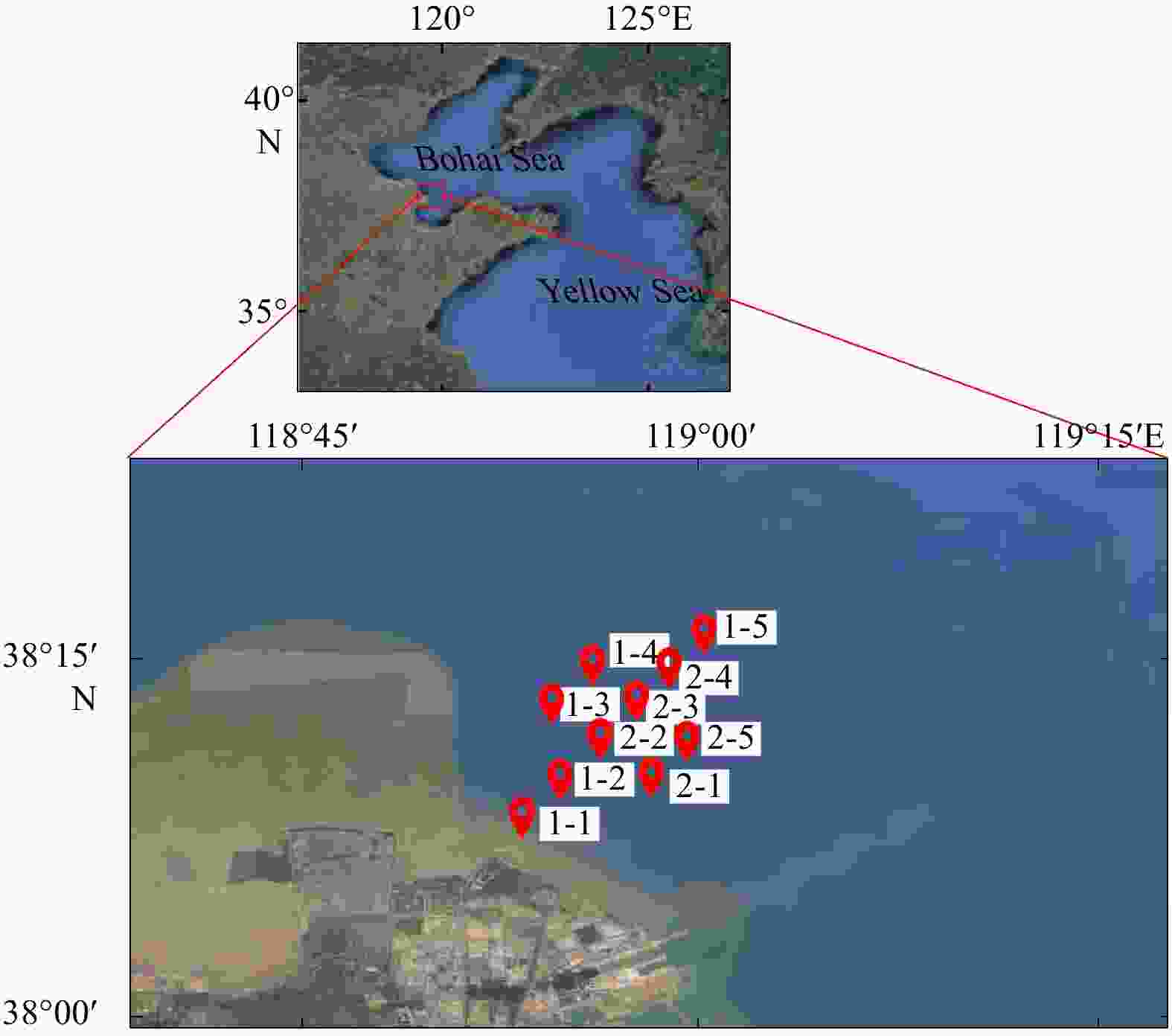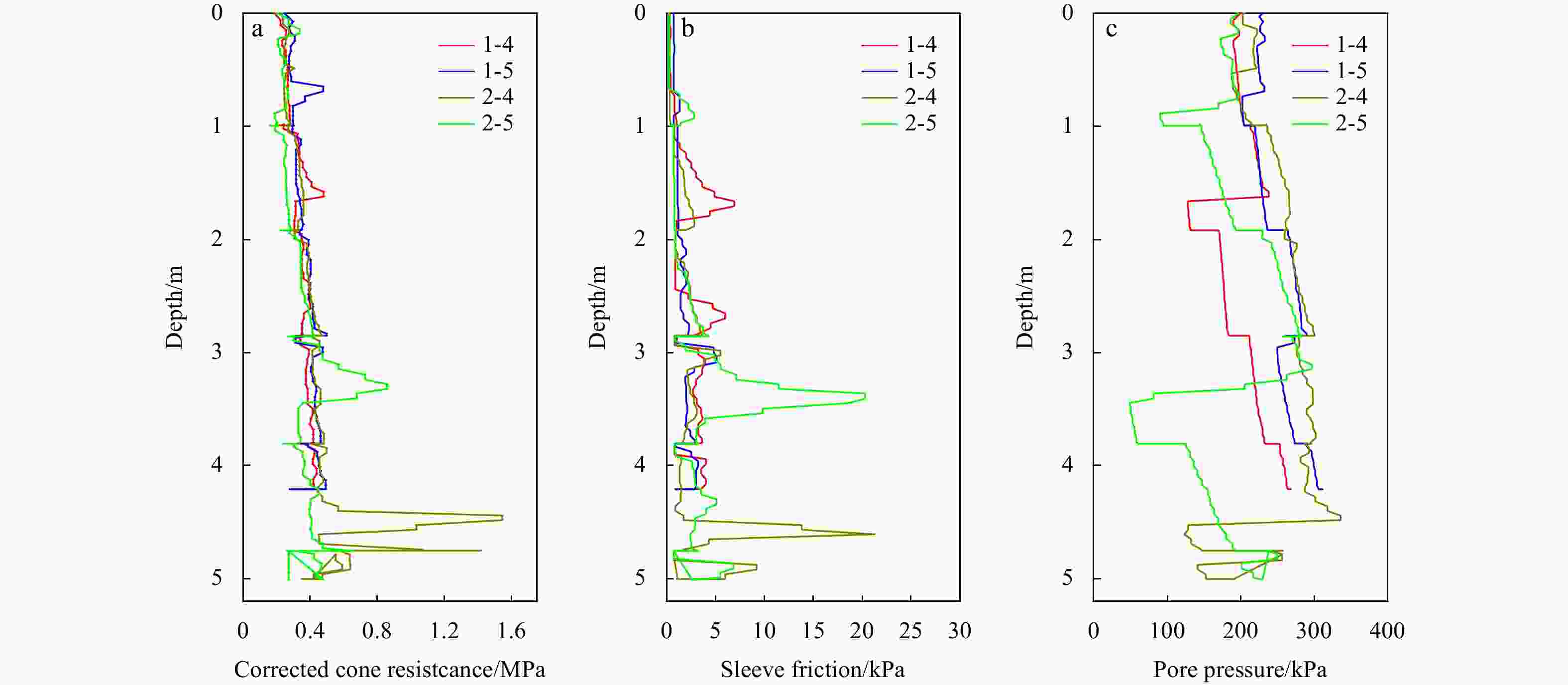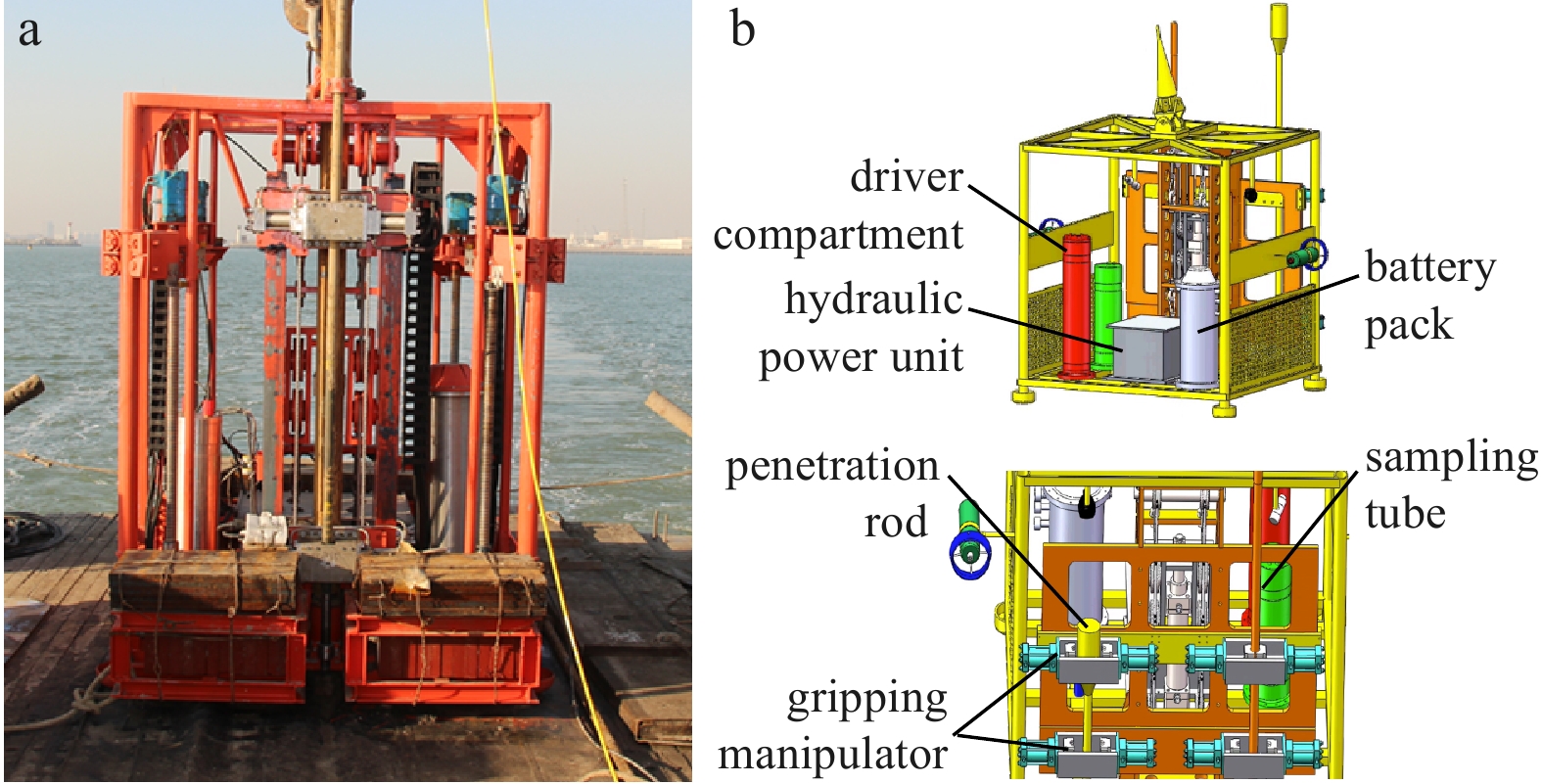A case study on the soil classification of the Yellow River Delta based on piezocone penetration test
-
Abstract: Piezocone penetration test (CPTu), the preferred in-situ tool for submarine investigation, is significant for soil classification and soil depth profile prediction, which can be used to predict soil types and states. However, the accuracy of these methods needs to be validated for local conditions. To distinguish and evaluate the properties of the shallow surface sediments in Chengdao area of the Yellow River Delta, seabed CPTu tests were carried out at ten stations in this area. Nine soil classification methods based on CPTu data are applied for soil classification. The results of classification are compared with the in-situ sampling to determine whether the method can provide sufficient resolution. The methods presented by Robertson (based on soil behavior type index Ic), Olsen and Mitchell are the more consistent and compatible ones compared with other methods. Considering that silt soils have potential to liquefy under storm tide or other adverse conditions, this paper is able to screen soil classification methods suitable for the Chengdao area and help identify the areas where liquefaction or submarine landslide may occur through CPTu investigation.
-
Figure 5. Soil-type classification based on the chart proposed by Robertson et al. (1986) (a), Robertson (1990) (b) and Robertson (2010) (c). OCR indicates overconsolidation ratio; Dr., density ratio; St, sensitivity; e, void ratio.
Figure 6. Soil type classification based on the chart proposed by Brouwer (2007) (a), Jefferies and Been (2006) (b), Eslami and Fellenius (1997) (c), and Olsen and Mitchell (1995) (d).
Table 1. Technical index of marine engineering geological environment in-situ investigation system
Item Value Item Value Working depth 1 500 m Hydraulic insert 10 MPa/ pull out 12 MPa Probing rod $\Phi$36 mm Control mode armored coaxial cable deck control Sampling tube $\Phi$75 mm/$\Phi$110 mm casing pipe Penetration way hydraulic step motor Penetration depth 7 m (One step penetration 1 m) Dimensions 2 000 mm×1 600 mm×2 000 mm Penetration rate 2 cm/s±5% Weight in air 4.5 t Table 2. Field parameters of the test points
Position Latitude Longitude Footage/m Water depth/m 1-1 38°08'07.86''N 118°54'07.86''E 4.2 7.0 1-2 38°09'36.42''N 118°54'44.16''E 4.2 8.5 1-3 38°11'24.60''N 118°53'15.06''E 4.2 10.0 1-4 38°14'03.18''N 118°55'13.32''E 4.2 16.0 1-5 38°17'53.28''N 119°00'57.42''E 4.2 19.0 2-1 38°09'39.00''N 118°57'01.92''E 4.2 10.0 2-2 38°10'25.50''N 118°55'18.72''E 1.3 10.0 2-3 38°13'01.86''N 118°57'15.78''E 4.8 15.5 2-4 38°14'08.10''N 118°58'06.06''E 5.0 16.5 2-5 38°11'24.63''N 118°58'57.84''E 5.0 15.5 Table 3. Proposed unification between 12 SBT zones and 9 SBTn zones (adopted from Robertson (2010))
SBT zone (Robertson et al., 1986) SBTn zone (Robertson, 1990),
SBT zone (Robertson, 2010)Proposed common SBT description 1 1 sensitive fine-grained 2 2 clay-organic soil 3 3 clays: clay to silty clay 4&5 4 silt mixtures: clayey silt & silty clay 6&7 5 sand mixtures: silty sand to sandy silt 8 6 sands: clean sands to silty sands 9&10 7 dense sand to gravelly sand 12 8 stiff sand to clayey sand* 11 9 stiff fine-grained* Note: * Overconsolidated or cemented. Table 4. Correlation level of different soil classification methods to the test points
Methods Point C3/K3 (Chu et al., 2017) Point in Dongying Port (Jia et al., 2011) Robertson et al. (1986) 65 65 Robertson (1990) 70 70 Robertson (2010) 65 65 Olsen and Mitchell (1995) 70 70 Eslami and Fellenius (1997) 50 50 Jefferies and Been (2006) 45 50 Brouwer (2007) 60 65 Ic 75 70 ISBT 65 60 -
[1] Abbaszadeh Shahri A, Malehmir A, Juhlin C. 2015. Soil classification analysis based on piezocone penetration test data—A case study from a quick-clay landslide site in southwestern Sweden. Engineering Geology, 189: 32–47. doi: 10.1016/j.enggeo.2015.01.022 [2] Baligh M M, Ladd C C, Vivatrat V. 1980. Cone penetration in soil profiling. Journal of the Geotechnical Engineering Division, 106(4): 447–461. doi: 10.1061/AJGEB6.0000948 [3] Begemann H K S. 1965. The friction jacket cone as an aid in determining the soil profile. In: Proceedings of the 6th International Conference on Soil Mechanics and Foundation Engineering. Montreal: Springer, 17–20 [4] Brouwer H. 2007. In Situ Soil Testing. East Sussex: Lankelma, 144 [5] Cai Guojun, Liu Songyu, Puppala A J. 2011. Comparison of CPT charts for soil classification using PCPT data: example from clay deposits in Jiangsu Province, China. Engineering Geology, 121(1-2): 89–96. doi: 10.1016/j.enggeo.2011.04.016 [6] Campanella R G, Robertson P K. 1988. Current status of the piezocone test. In: Proceedings of the 1st International Symposium on Penetration Testing. Orlando, FL: Pergamon Press, 93–116 [7] Chu Lipeng, Sun Yongfu, Song Yupeng, et al. 2017. Application of seabed cone penetration test in research on the seafloor geotechnical engineering characteristics in the Yellow River Estuary. Coastal Engineering, 36(1): 22–33 [8] Douglas B J, Olsen R S. 1981. Soil classification using electric cone penetrometer. In: Cone Penetration Testing and Experience. St. Louis, MO: ASCE, 209–227 [9] Du Guangyin, Gao Changhui, Liu Songyu, et al. 2019a. Evaluation method for the liquefaction potential using the standard penetration test value based on the CPTU soil behavior type index. Advances in Civil Engineering, 2019: 5612857 [10] Du Xing, Sun Yongfu, Song Yupeng, et al. 2019b. In site monitoring of wave-induced pore pressure of silt in Chengdao sea area of Yellow River Estuary. Haiyang Xuebao (in Chinese), 41(7): 116–122 [11] Eslami A, Alimirzaei M, Aflaki E, et al. 2017. Deltaic soil behavior classification using CPTU records—Proposed approach and applied to fifty-four case histories. Marine Georesources & Geotechnology, 35(1): 62–79 [12] Eslami A, Fellenius B H. 1997. Pile capacity by direct CPT and CPTu methods applied to 102 case histories. Canadian Geotechnical Journal, 34(6): 886–904. doi: 10.1139/t97-056 [13] Jefferies M G, Been K. 2006. Soil Liquefaction—A Critical State Approach. New York: Taylor & Francis, 206-217 [14] Jefferies M G, Been K. 2015. Soil Liquefaction: A Critical State Approach. Boca Raton, FL: CRC Press [15] Jefferies M G, Davies M P. 1991. Soil classification by the cone penetration test: Discussion. Canadian Geotechnical Journal, 28(1): 173–176. doi: 10.1139/t91-023 [16] Jefferies M G, Davies M P. 1993. Use of CPTU to estimate equivalent SPT N60. Geotechnical Testing Journal, 16(4): 458–468. doi: 10.1520/GTJ10286J [17] Jia Yonggang, Huo Suxia, Xu Guohui, et al. 2004. Intensity variation of sediments due to wave loading on subaqueous delta of Yellow River. Rock and Soil Mechanics, 25(6): 876–881 [18] Jia Yonggang, Shan Hongxian, Yang Xiujuan, et al. 2011. Sediment Dynamics and Geologic Hazards in the Estuary of Yellow River, China. Beijing: Science Press, 103–116 [19] Jones G A, Rust E. 1982. Piezometer penetration testing CUPT. In: 2nd European Symposium on Penetration Testing. Amsterdam: CRC Press, 607–613 [20] Ku C S, Ou C Y, Juang C H. 2010. Reliability of CPT IC as an index for mechanical behaviour classification of soils. Géotechnique, 60(11): 861–875 [21] Long M. 2008. Design parameters from in situ tests in soft ground—recent developments. In: Geotechnical and Geophysical Site Characterization. Taipei: CRC Press, 97–124 [22] Meng Xiangmei, Jia Yonggang, Liu Xiaoli. 2008. Study on zoning and liquefaction induced by wave of Chengdao in Yellow River Delta. Journal of Engineering Geology, 16(S1): 44–53 [23] Olsen R S, Mitchell J K. 1995. CPT stress normalization and prediction of soil classification. In: International Symposium on Cone Penetration Testing. Linköping: SGI report, 257–262 [24] Osman M A, Ahmed E F O. 2003. Evaluation of cone penetration test (CPT) classification methods for some local soils. Journal of Building and Road Research, 5(1): 37–46 [25] Ramsey N. 2002. A calibrated model for the interpretation of cone penetration tests (CPTs) in North Sea Quaternary Soils. In: Offshore Site Investigation and Geotechnics: Diversity and Sustainability. London, OnePetro, 341–356 [26] Robertson P K. 1990. Soil classification using the cone penetration test. Canadian Geotechnical Journal, 27(1): 151–158. doi: 10.1139/t90-014 [27] Robertson P K. 2009. Interpretation of cone penetration tests—a unified approach. Canadian Geotechnical Journal, 46(11): 1337–1355. doi: 10.1139/T09-065 [28] Robertson P K. 2010. Soil behaviour type from the CPT: an update. In: 2nd International Symposium on Cone Penetration Testing. Huntington Beach: Cone Penetration Testing Organizing Committee, 575–583 [29] Robertson P K. 2016. Cone penetration test (CPT)-based soil behaviour type (SBT) classification system—An update. Canadian Geotechnical Journal, 53(12): 1910–1927. doi: 10.1139/cgj-2016-0044 [30] Robertson P K, Campanella R G, Gillespie D, et al. 1986. Use of piezometer cone data. In: Use of in Situ Tests in Geotechnical Engineering. Blacksburg, VA: ASCE, 1263–1280 [31] Robertson P K, Wride C E. 1998. Evaluating cyclic liquefaction potential using the cone penetration test. Canadian Geotechnical Journal, 35(3): 442–459. doi: 10.1139/t98-017 [32] Sanglerat G, Nhim T V, Sejourne M, et al. 1974. Direct soil classification by static penetrometer with special friction sleeve. In: 1st European Symposium on Penetration Testing. Stockholm: National Swedish Building Research, 337–344 [33] Santoso P B, Yanto, Apriyono A, et al. 2018. Inverse distance weighting interpolated soil properties and their related landslide occurrences. MATEC Web of Conferences, 195: 03013. doi: 10.1051/matecconf/201819503013 [34] Schmertmann J H. 1975. Measurement of in situ shear strength. In: In Situ Measurement of Soil Properties. Raleigh, NC: ASCE,57–138 [35] Schneider J A, Randolph M F, Mayne P W, et al. 2008. Analysis of factors influencing soil classification using normalized piezocone tip resistance and pore pressure parameters. Journal of Geotechnical and Geoenvironmental Engineering, 134(11): 1569–1586. doi: 10.1061/(ASCE)1090-0241(2008)134:11(1569) [36] Senneset K, Janbu N. 1985. Shear strength parameters obtained from static cone penetration tests. In: Strength Testing of Marine sediments: Laboratory and In-Situ Measurement. West Conshohocken, PA: ASTM International, 41–54 [37] Shen Shuilong, Wang Junpeng, Ma Lei. 2010. Identification of soil stratigraphy of soft deposit in Shanghai from CPTU test. In: Deep Foundations and Geotechnical In Situ Testing. Shanghai: ASCE, 384–392 [38] Wroth C P. 1984. The interpretation of in situ soil tests. Géotechnique, 34(4): 449–489 [39] Wroth C P. 1988. Penetration testing: a more rigorous approach to interpretation. In: 1st International Symposium on Penetration Testing. Orlando, FL: Pergamon Press, 303–311 [40] Xu Guohui, Sun Yongfu, Wang Xin, et al. 2009. Wave-induced shallow slides and their features on the subaqueous Yellow River delta. Canadian Geotechnical Journal, 46(12): 1406–1417. doi: 10.1139/T09-068 [41] Yang Zhongnian, Liu Xuesen, Guo Lei, et al. 2020. Evaluation of the soil characteristic parameters of the Yellow River Subaqueous Delta using CPT. Marine Georesources & Geotechnology, [42] Zhou Liangyong, Liu Jian, Liu Xiqing et al. 2004. Coastal and marine geo-hazards in the modern Yellow River Delta. Marine Geology & Quaternary Geology, 24(3): 19–27 -





 下载:
下载:










